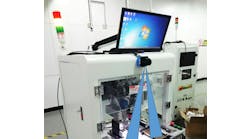Mike Bacidore is the editor in chief for Control Design magazine. He is an award-winning columnist, earning a Gold Regional Award and a Silver National Award from the American Society of Business Publication Editors. Email him at [email protected].
What impact, if any, has wireless technology had on presence sensors with robots?
We posed this question to a panel of industry veterans. They include Chris Elston, senior controls engineer, Yamaha Robotics; Scott Mabie, general manager of Americas region, Universal Robots; Helge Hornis, manager intelligent systems group, Pepperl+Fuchs; Victor Caneff, business development manager, assembly and robotics, Banner Engineering; and Balluff marketing managers Wolfgang Kratzenberg, industrial identification, Henry Menke, position sensing, and Shishir Rege, networking. Here's what they had to say.
For more Q&A sessions from the panel, click here.
Kratzenberg: Ultimately, wireless technology has boosted the brain power of robots. Think RFID. In many applications RFID can be seen as an evolution from the simpler presence sensors. Now, instead of just identifying that something is present, we can identify with certainty what actually is present. Logic in the controls can then instruct the robot to perform a task based on the information saved in the RFID tag's memory.
For instance, placing a tag on the end of arm tooling to identify the correct tool is being used for the correct job. In addition to a unique identifier specific to that tool, other information such as usage, maintenance and process data can be stored on the tag, as well. Basically, the reader is placed on the end of the robot arm, and the robot is instructed to look for a specific tool. When the reader identifies the correct tool the robot can couple with the tool. This ensures the correct tool is being used and it has been properly maintained and it is fit to perform the task. This is all accomplished by sending data through the air wirelessly.
Mabie: Wireless technology is still considered not safe enough within the industry. It’s always easier to see a broken wire than invisible electromagnetic signals. But the technology has been getting increasingly robust and will definitely be influencing the industry in the near future.
Hornis: We have not been involved in dedicated wireless technologies for robot control systems. Instead, we are working on SmartBridge, a wireless interfacing technology for a certain class of industrial sensors and, in addition to typical machine applications, may be beneficial in robotics, as well.
In a nutshell, SmartBridge interfaces with IO-Link and other intelligent sensing devices and allows users to perform configuration and maintenance operations using smartphones and tablets.
In addition to this user-centric utilization, it is, of course, possible to intercept the wireless traffic using other devices or computers. In this scenario, SmartBridge acts as a parallel communication channel between the sensor and, for instance, an automated maintenance system. While the process controller, for example, the PLC, is using the sensor data to run the process, SmartBridge sends other data such as temperature or operating hours to the maintenance system.
Imagine a sensor that monitors the rotational speed of an electric motor. The PLC is tasked with keeping the speed within certain tolerances. Combining this data with the current consumption of the motor, obtained from a second sensor, and the shaft temperature, from a third sensor, will allow the maintenance system to predict possible production interrupts due to bearing failure. Having enough data points will enable preventive maintenance to be scheduled without a loss in machine uptime and productivity.
Caneff: With the necessity of deploying sensors on robot end effectors, cables that are being continuously flexed can become unreliable and a maintenance burden due to frequent replacement. The use of wireless I/O to transmit analog and digital signals from sensors on the robot to the control system can improve the overall system reliability.
Elston: Wireless sensing is only handy to reduce the wiring harness on a robotics arm. There is certainly always a concern when too many sensors, air lines or motor cables are dangling from a robotics arm that could be flexed over time and cause failure. Or even snagging on another object in the work cells is typically the normal "death" of basic sensors on a robot EOAT. Honestly, I have seen too many wireless sensors on robots, but it seems a good place to start would be basic sensing of EOATs that could reduce some of that labor headache of looming wires from the base of the robot all the way to the tooling.




